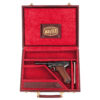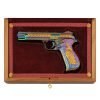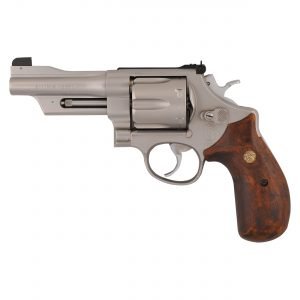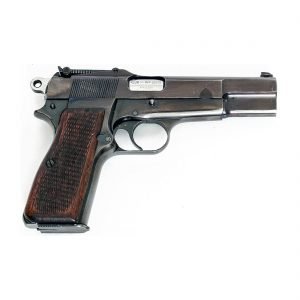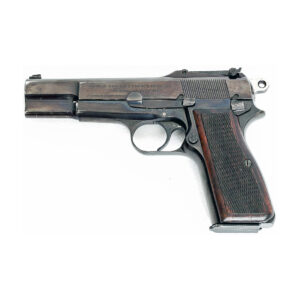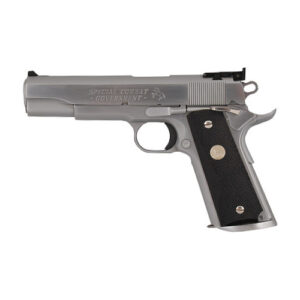Nagant M1895 Belçika 1910 Düşer Top 7.62mm
Nagant M1895 Belgian 1910 Swingout Cylinder Revolver 7.62mm
Model: Belgian 1910 Swingout Cylinder Revolver
Çapı: 7.62x38R (7.62mm Nagant)
Namlu Boyu: 4.5″ (11.4 cm)
Kapasite: 7
Ağırlık: 28 oz | 795 gr (boş)
Uzunluk: 9.25″ | 235 mm
Sistem: Single/Double Action
Açıklama: M1895 modelinin yerini almak üzere Belçika Liege’de yalnızca 2.500 adet üretilmiştir. Düşer top yeniliği ile daha hızlı doldurulabildiğinden dönemin diğer yeni yarı otomatik silahlarıyla rekabet edebilir duruma gelmiştir. Atış sırasında gaz kaçağının önlenmesi açısından her iki single/double action kullanımda da top namluya doğru öne hareket etmektedir. I. Dünya savaşının aniden başlaması sonucu maalesef Rusya tarafından kullanıma alınamamıştır.
Açıklama
Nagant M1895 The Belgian 1910 Swingout Cylinder Revolver
The 7.62mm 1910 Nagant swing out cylinder revolver was made at Liege and it was being tested as a replacement for the M1895. It is a true gas seal revolver and uses the same 7.62x38R cartridge as the M1895 but is quicker and easier to reload. This was probably done to make it more competitive with the new automatic pistols appearing at the time. Unfortunately the First World War came along and it was never accepted into Russian service.
When the M1895 Nagant revolver was originally selected for service with the Russian Army, the criteria put forth by the test commission included the following:
Fired cases must be individually extracted (that is, not automatically or simultaneously). The members of the commission decided that “the necessity for repeated reloading of the revolver while in use in close proximity to a pressing enemy would only occur in isolated instances, undoubtedly, it would be a complicated and heavy revolver. The price of manufacture for such a revolver would be higher and information on revolvers of reduced caliber obtained by the commission in the period of 1888 – 1892 from various other countries, that did not use automatic (simultaneous) extraction showed satisfactory results.”
The test commission actually disqualified revolvers submitted for testing on the basis of this criteria, most notably the revolver of Henri Pieper. It had other problems, but simultaneous extraction was the primary reason it was originally rejected.
The 1910 revolver has a true gas seal mechanism. The cylinder advances to move the mouth of the cartridge into the barrel stub when the hammer is cocked either manually in single action mode or automatically in double action mode.
The firing mechanism is “triple action” just like the Officer’s model M1895, in other words, the revolver can be manually cocked and then fired by pulling the trigger, or fired with the hammer in the uncocked position by simply pulling the trigger. Since it is a gas seal the act of pulling the trigger in double action mode has to move the cylinder forward, making the double action trigger pull fairly heavy (but not as heavy as the Standard Service M1895).
The cylinder swings out to the right side of the revolver for reloading. This was typical of most cavalry revolvers of the time. The revolver was carried in a backwards or butt forward holster on the horseman’s right side and cross drawn with the left hand. Reloading was accomplished by swinging the cylinder out and carrying out the loading operation with the right hand. The “loading gate” on the 1910 actually functions as a latch to retain the cylinder in place.
The 1910 revolver features a star extractor which pushed the spent cartridges from the cylinder. To reload the 1910, the “loading gate” was pulled to the rear releasing the cylinder to swing out to the right side of the revolver. The ejector rod would be pushed and the all of cartridges would be simultaneously pushed backwards to free them from the cylinder. Since the 7.62x38R cartridge is very long, the star only pushes them about half way out, but this was enough to free them so they could be shaken free from the cylinder. Once the cylinder was emptied, new cartridges could be loaded with the right hand and a flip of the revolver would replace the cylinder in the frame and the shooter was ready to continue.

